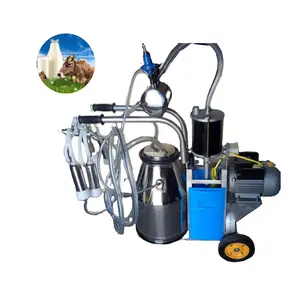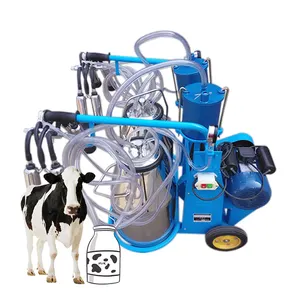Popular in your industry

































Top categories
About farm milking machines
Types of farm milking machines
Farm milking machines are devices designed to efficiently and hygienically extract milk from cows on a large scale. Farm milking machines are generally divided into two categories: portable milking machines and stationary milking machines.
- Portable milking machines
Portable milking machines are small milking machines that can be taken to the cow, instead of the cow having to walk to a fixed location. They are convenient for small-scale farms or farms with limited infrastructure. Portable milking machines generally consist of the following components:
A vacuum pump creates negative pressure, which makes the milk flow from the cow's udder into the collection container. A pulsator controls the vacuum pressure and regulates the milking process to simulate the natural milking rhythm of hand milking. A collection container is where the milk is stored during the milking process. Some portable milking machines have a built-in battery or the option to use a car adapter, allowing them to operate without being connected to an electrical outlet.
- Stationary milking machines
Stationary milking machines are fixed installations that milk multiple cows simultaneously. They are suitable for large-scale commercial dairy farms. Stationary milking machines generally consist of the following components:
Vacuum pump and receiver groups: The vacuum pump creates negative pressure, which makes the milk flow from the cow's udder into the receiver group. The receiver group is a collection container that stores the milk during the milking process.
Milk cluster: The milk cluster is a device that connects the cows to the milking machine. It contains teat cups that gently and efficiently extract the milk from the cow's udder.
Pulsator: The pulsator controls the vacuum pressure and regulates the milking process to simulate the natural milking rhythm of hand milking.
Specification and maintenance of farm milking machines
Proper machine specifications and maintenance are essential for the efficient and hygienic functioning of milking machines. Several machine specifications are important for the user to be aware of. These can vary due to the type of machine, its brand, and model, and whether the machine is portable or stationary.
For all machines, it is important to periodically check and maintain the vacuum level, which is typically around 13 inches of mercury. The pulsator rate is the number of pulsations per minute, and the pulsator ratio is the proportion of time the liner is open to the closed time. Both of these should be checked to ensure a good blood flow in the cow's udder. The claw size should be suitable for the size of the cow, and it should be cleaned and disinfected after each use. The milk hose is the tube through which milk travels from the teat cup to the storage container. It should be flexible and clean.
Generally, the machine is cleaned thoroughly after each milking to ensure the hygienic quality of the milk. This can be done using hot water and an alkaline detergent, followed by acid rinse, and then sanitized with a suitable solution. The milk hose needs to be flushed with water or air to remove any milk residue. The machine should be dried and lubricated after cleaning. The vacuum pump should be serviced annually, whereas the milk pump should be serviced every six months. The vacuum level should be checked regularly, and the milk storage tank should be cleaned and disinfected after each use. Typically, the storage tank has an automatic washing system where the tank is rinsed with water and an alkaline detergent and then sanitized with an acid rinse solution.
These are general guidelines, and users should always refer to the manufacturer's recommendations for specific maintenance procedures and schedules. The manual will also contain information on the amount of water, temperature, and pressure that should be used during the cleaning of the machine.
Scenarios of farm milking machines
Farm milking machines provide a modern and efficient approach to managing milk production on dairy farms. These machines support various areas of milk production, thus streamlining the milking process and enhancing productivity. Here are some scenarios that show how farm milking machines are used in dairy farms.
- Automated milking
Farm milking machines automate the milking process. This reduces the need for manual labor and allows for increased efficiency in the milking routine. The automated process also ensures consistent milking techniques, which results in high-quality milk production. Ultimately, this streamlines milk production and boosts the overall productivity of the dairy farm.
- Health monitoring
Some farm milking machines are equipped with health monitoring features. Such as the milk temperature, somatic cell count, fat content, etc. These features can be used to monitor the health and well-being of the cows in real time. By ensuring that cows are in optimal health, farm managers can maintain the quality of milk production and address any health issues promptly.
- Optimization of milk quality
Using farm milking machines can optimize milk quality. Farm milking machines ensure cleanliness and hygiene during the milking process, preventing contamination of the milk. This helps in reducing the risk of quality issues such as bacteria entering the milk, which enables the farm to adhere to high-quality standards and regulations. Moreover, the prompt collection and cooling of milk with these machines limit bacterial growth and maintain its quality. With better quality control, farm managers can produce milk that meets premium market demands and fetch higher prices.
- Reduction of labor
Using farm milking machines reduces labor requirements on the farm. After setting up the machine, only a single farm worker is required to operate the machine. This is a significant improvement over traditional manual milking, which necessitates more manual labor. The machine's ability to manage the milking of several cows at once also accelerates the milking process. As a result, the farm can run more effectively and profitably by using the machine.
How to choose farm milking machines
The following factors will help farmers decide on the right kind of milking machine for their farms.
- Farm size and scale
Large-scale dairy farms will perform better with automatic milking machines. They are faster and can handle up to 1000 cows every day. On the other hand, small-scale farms can do well with manual and portable machines. They may not be efficient, but they are affordable.
- Cost of the machine
Farmers should consider their budget and find a machine that they can afford. Automatic machines are more expensive than manual ones. The number of cows on the farm and the type of machine will also affect the price. If the farm has many cows, the farmer will need to get a machine that is strong and durable.
- Comfort for the cows
Choose a machine that will make the cows feel comfortable. A machine with a pulsator will be best to use. It is also a good idea to use a machine that is easy to clean and to maintain. Cows will be happy to come and be milked daily.
- Energy source
Choose a machine that works with the available energy source. Electric machines are the most popular and can work well with solar power. Some farms will prefer to use gas or diesel-powered machines. No matter the choice, the machine must be able to work smoothly on the farm.
Q&A
Q: How often should a dairy farmer milk his cows?
A: Dairy cows should be milked at least twice a day. However, during the first two months after calving, the cows should be milked thrice a day to stimulate more milk production.
Q: What is the best way to clean a milking machine?
A: Start by disassembling the machine and washing all parts in warm water with a dairy cleaning solution. Use a brush to scrub any dirt or residue. Rinse thoroughly and allow the parts to dry before reassembling the machine. Additionally, sanitize the machine by running a dairy-approved sanitizing solution, such as iodine, through the entire system.
Q: How long does it take to milk a cow with a milking machine?
A: A cow takes approximately 5-7 minutes to be milked with a milking machine.
Q: How can dairy farmers improve their milk quality and yield?
A: Dairy farmers can improve their milk quality and yield by ensuring proper nutrition and hydration for their cows. Maintaining a clean and hygienic milking environment, monitoring cow health and promptly addressing any issues that arise. Additionally, practicing good milking techniques, such as proper machine attachment and thorough udder cleaning, can also help in improving milk quality and yield.





























